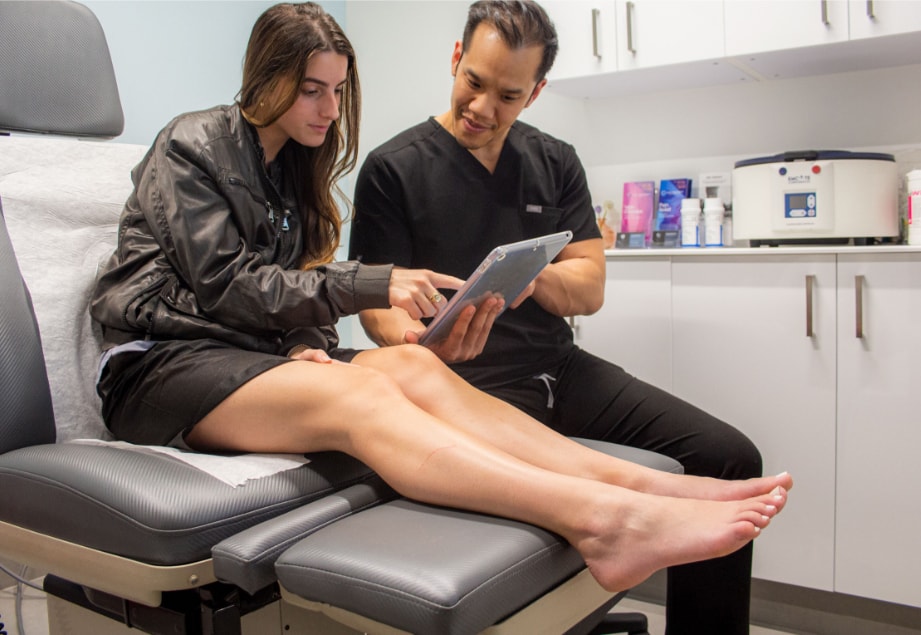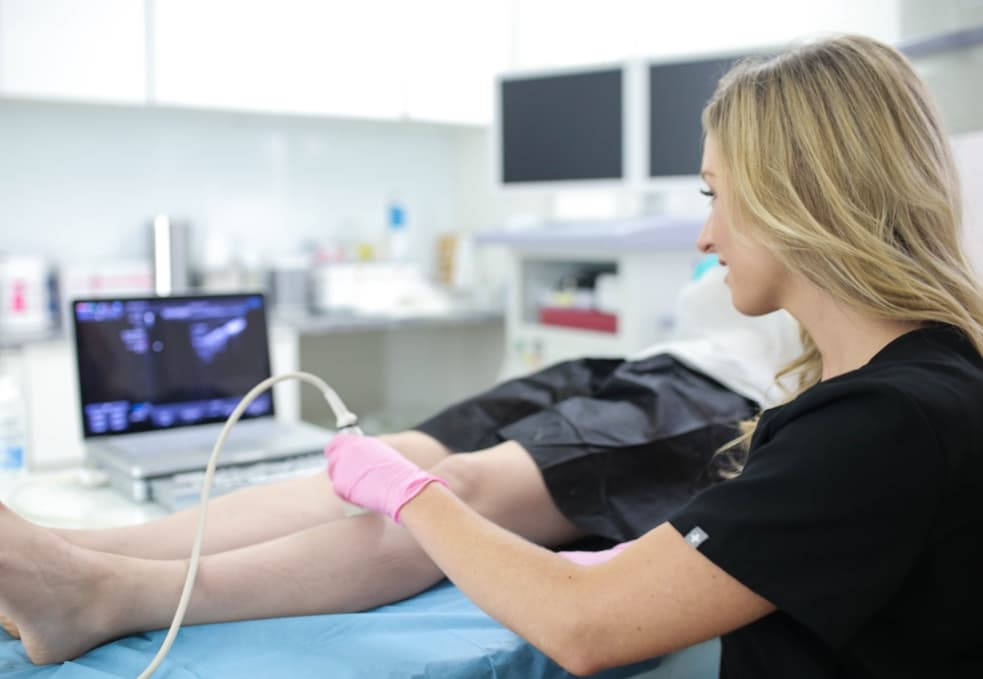If you’re a Long Island resident dealing with vein issues such as varicose veins or spider veins, you’re not alone. These common vascular conditions affect millions of people across the United States. Fortunately, Long Island Vein Center is here to help you find relief from these issues with our state-of-the-art vein treatments led by board-certified vein doctors. In this guide, we will explore the top 5 vein treatments available for Long Island residents, ensuring you have all the information you need to make an informed decision about your vein health.

1. Sclerotherapy
Sclerotherapy is a minimally invasive vein treatment offered at Long Island Vein Center. It is primarily used to address spider veins, those small, unsightly veins that often appear on the legs. During the procedure, a specialized solution is injected directly into the affected veins. This solution irritates the lining of the veins, causing them to collapse and eventually fade from view. Sclerotherapy is a quick, virtually painless outpatient procedure with little to no downtime, making it an excellent choice for those seeking to improve the appearance of their legs.
How It Works
Sclerotherapy works through a process known as chemical ablation. A sclerosing agent, typically a saline solution with added detergents or foaming agents, is injected into the targeted spider veins. Upon contact with the vein’s inner lining, the sclerosing agent induces an inflammatory response. This irritation causes the vein to constrict and collapse, effectively sealing it off. Over time, the treated vein is absorbed by the body, and blood circulation is rerouted through healthier veins. This minimally invasive process leads to the gradual disappearance of the treated spider veins.
Benefits:
- Minimally invasive
- Virtually painless
- Quick outpatient procedure
- Little to no downtime
- Effective for spider veins
- Improves leg aesthetics
- High success rates
- Low risk of complications
2. Endovenous Laser Ablation (EVLA)
Endovenous Laser Ablation, commonly referred to as EVLA, is a highly advanced and minimally invasive vein treatment. During EVLA, a thin laser fiber is inserted into the diseased vein through a tiny incision. Once positioned correctly, laser energy is emitted, heating and sealing the problematic vein. This process redirects blood flow to healthier veins, alleviating the discomfort and cosmetic issues associated with varicose veins. EVLA offers a rapid recovery with minimal discomfort, making it a preferred choice for many seeking varicose vein relief.
How It Works
Endovenous Laser Ablation (EVLA) functions based on the principle of photothermal ablation. A specialized laser fiber is introduced into the affected vein, guided by ultrasound. The laser emits concentrated energy in the form of light, which is absorbed by the vein’s walls. This energy causes the vein to heat up, leading to thermal injury and subsequent closure. Over time, the treated vein is absorbed by the body, while blood flow is rerouted through healthier vessels. EVLA offers precise and effective treatment for varicose veins.
Benefits:
- Minimally invasive procedure
- High success rate in treating varicose veins
- Rapid recovery with minimal discomfort
- No need for general anesthesia
- Improved blood circulation
- Enhanced leg aesthetics
- Low risk of complications
- Short procedure time
- Outpatient treatment option
3. Radiofrequency Ablation (RFA)
Radiofrequency Ablation (RFA) is a cutting-edge and minimally invasive procedure used to treat varicose veins effectively. During RFA, a thin catheter is inserted into the diseased vein under ultrasound guidance. This catheter delivers radiofrequency energy to the vein wall, heating it and causing it to collapse. Once the problematic vein is sealed off, blood is rerouted through healthier veins, alleviating the symptoms and appearance of varicose veins. RFA offers a quick recovery and is often performed without the need for general anesthesia.
How It Works
Radiofrequency Ablation (RFA) employs the principles of thermal ablation to treat varicose veins. A specialized catheter is inserted into the targeted vein, guided by ultrasound imaging. Once in place, the catheter emits radiofrequency energy, which generates heat. This controlled heat causes the collagen in the vein’s walls to contract and the vein to collapse. Subsequently, the treated vein is gradually reabsorbed by the body, while blood flow is redirected through healthier vessels. RFA is a precise method for treating varicose veins.
Benefits:
- Minimally invasive procedure
- Highly effective in treating varicose veins
- Minimal discomfort during and after treatment
- Quick recovery with little to no downtime
- No need for general anesthesia
- Improved blood circulation
- Enhanced leg aesthetics
- Low risk of complications
- Outpatient treatment option
4. VenaSeal
VenaSeal is an innovative and minimally invasive treatment for varicose veins. This procedure utilizes a medical adhesive to seal off the affected vein, effectively closing it. A small catheter is used to deliver the adhesive, and once applied, it triggers vein closure. VenaSeal is virtually painless, and patients typically experience little to no discomfort. Unlike traditional treatments, it doesn’t require heat or multiple injections. This innovative approach offers a quick recovery, enabling patients to resume their daily activities soon after treatment.
How It Works
VenaSeal operates on the principle of medical adhesive closure. A catheter is inserted into the diseased vein, guided by ultrasound imaging. At the desired location, a specialized medical adhesive is dispensed into the vein. This adhesive binds the vein walls together, immediately sealing it off. Blood flow is redirected through healthier veins, and the treated vein eventually gets absorbed by the body over time. VenaSeal is a precise and innovative approach that eliminates the need for heat or multiple injections.
Benefits:
- Minimally invasive and virtually painless
- No need for heat or multiple injections
- Quick recovery with little to no downtime
- High success rate in treating varicose veins
- Improved leg aesthetics
- Minimal discomfort during and after the procedure
- Patients can typically resume daily activities promptly
- Low risk of complications
- Outpatient treatment option
5. Ambulatory Phlebectomy
Ambulatory phlebectomy is a specialized and minimally invasive surgical technique used to treat varicose veins. During this procedure, tiny incisions are made over the targeted varicose veins, and a hook-like instrument is used to remove the veins through these small openings. Ambulatory phlebectomy is particularly effective for larger varicose veins that may not respond well to non-surgical treatments. It offers the advantage of both symptom relief and improved leg aesthetics with minimal scarring.
How It Works
Ambulatory phlebectomy involves surgical vein removal. After local anesthesia is administered, small incisions are made over the varicose veins to be treated. A special hook-like instrument is then used to carefully extract the veins through these incisions. The procedure is precise and allows for the targeted removal of problematic veins, offering symptom relief and cosmetic improvement. Despite being a surgical intervention, ambulatory phlebectomy is minimally invasive, resulting in minimal scarring and a relatively quick recovery.
Benefits:
- Effective for larger varicose veins
- Minimally invasive surgical technique
- Local anesthesia reduces discomfort
- Precise removal of targeted veins
- Improved leg aesthetics
- Minimal scarring due to small incisions
- Rapid recovery with minimal downtime
- Symptom relief from varicose veins
- Outpatient procedure
Vein Treatment FAQs
What are the common symptoms of varicose veins and spider veins?
- Varicose Veins: Common symptoms of varicose veins include visible, twisted, and bulging veins, aching or throbbing pain, muscle cramps, and swelling in the legs.
- Spider Veins: Spider veins are characterized by small, web-like clusters of red, blue, or purple veins near the surface of the skin. While they are generally not painful, they can cause itching or burning sensations.
Are vein treatments painful?
Most vein treatments are minimally invasive and cause minimal discomfort. Local anesthesia is used during procedures like sclerotherapy, endovenous laser ablation (EVLA), radiofrequency ablation (RFA), VenaSeal, and ambulatory phlebectomy to minimize pain. Patients typically report feeling only mild sensations such as a slight prick or warmth during the treatments.
How long does it take to recover from vein treatments?
Recovery time varies depending on the specific treatment and the individual. Generally, minimally invasive vein treatments have short recovery periods. Patients can usually return to their normal activities immediately, provided they avoid strenuous workouts for a few days.
Can I drive myself home after a vein treatment procedure?
In most cases, you should be able to drive yourself home after minimally invasive vein treatments. The use of local anesthesia means you won’t be impaired by the treatment. However, it’s a good idea to have someone accompany you to the appointment in case you need assistance afterward.
Will I need multiple sessions for vein treatment?
The number of sessions required depends on the severity of your vein condition and the chosen treatment method. Some patients may achieve the desired results with just one session, while others may require multiple sessions spread over several weeks. Your vein specialist will create a treatment plan and discuss the expected number of sessions during your consultation.
Is vein treatment covered by insurance?
Many insurance plans do cover vein treatments, especially when they are medically necessary to alleviate symptoms or prevent complications. At Long Island Vein Center, we offer free insurance verification to help you determine your coverage before your first appointment. We work with most major insurance providers to ensure you receive the benefits you’re entitled to.
Are there any risks associated with vein treatments?
While vein treatments are generally safe, like any medical procedure, they carry some risks. Potential risks include minor bruising, swelling, and discomfort. Serious complications are rare but may include infection, blood clots, or skin discoloration. It’s essential to choose a board-certified vein doctor and discuss any concerns or pre-existing conditions.
How long do the results of vein treatments last?
The longevity of the results depends on several factors, including the type of treatment and the individual’s overall vein health. In most cases, vein treatments provide long-lasting relief from varicose veins and spider veins. However, new veins may develop over time, and maintenance treatments may be necessary to preserve the results.
Can vein issues return after treatment?
While vein treatments are highly effective, it’s possible for new vein issues to develop in the future, especially if risk factors like genetics, lifestyle, or occupation remain unchanged. To reduce the likelihood of recurrence, it’s essential to follow your vein specialist’s post-treatment care recommendations and adopt a healthy lifestyle, including regular exercise and wearing compression stockings if recommended.
Are there any lifestyle changes I should make before or after vein treatment?
Before your vein treatment, your doctor may advise you to stop certain medications or dietary supplements that can increase bleeding or interfere with the procedure. After treatment, it’s important to maintain a healthy lifestyle, including regular exercise, a balanced diet, and staying well-hydrated. Your vein specialist will provide specific guidance tailored to your needs.
Visit Long Island Vein Center Today
Long Island residents dealing with varicose veins or spider veins can find hope and relief at Long Island Vein Center. Our board-certified vein doctors are dedicated to providing you with the best possible care and treatment options. By seeking expert advice and exploring minimally invasive treatments, you can enjoy the benefits of improved vein health and enhanced confidence in your appearance. Don’t let vein issues hold you back from living your life to the fullest. Contact us today to schedule a consultation.

